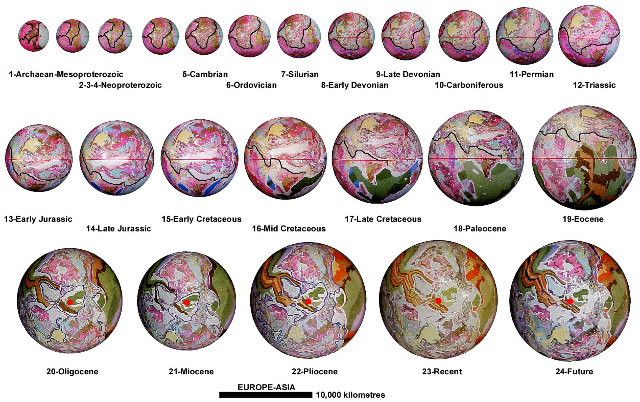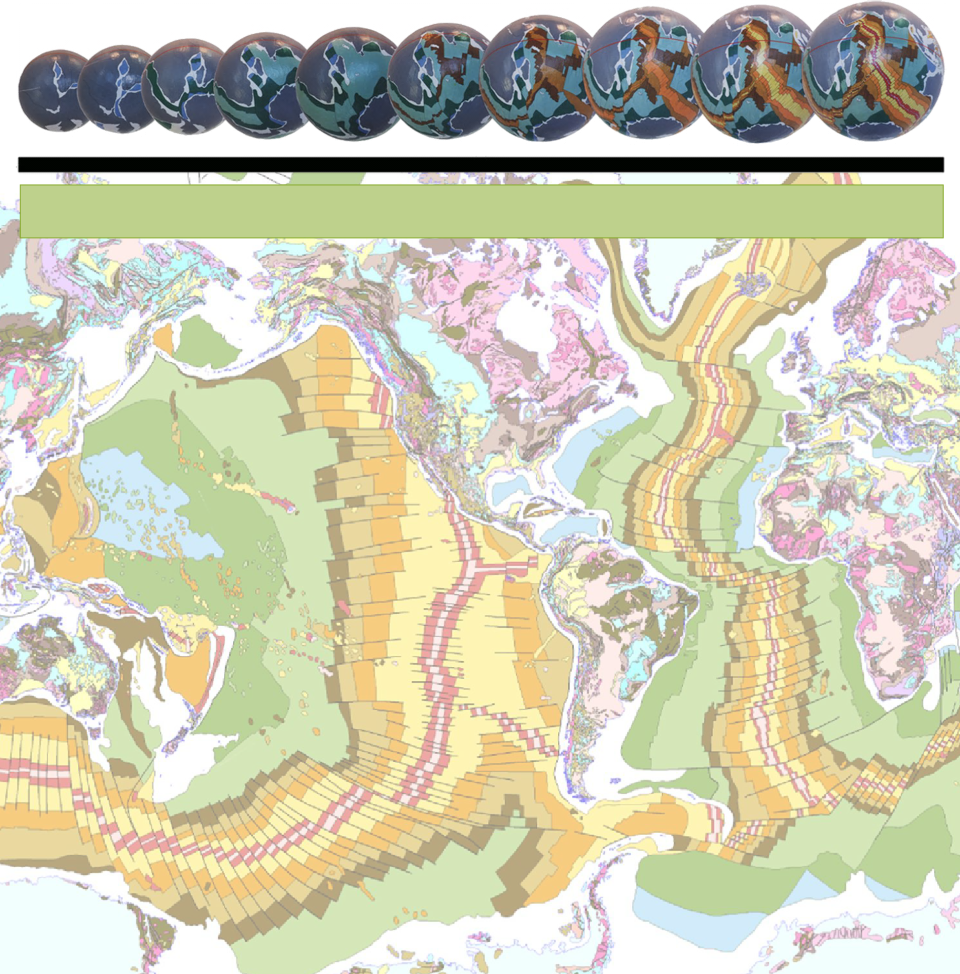EUROPE, RUSSIA AND ASIA
The European and Asian continent, inclusive of Russia, is a vast area and constitutes the largest land mass on Earth today. In plate tectonic studies a large Tethys Ocean is depicted as being located between the fragmented remains of the present European and Asian continent and is inferred to have covered many small crustal plates, as well as Cretaceous island-arcs and small continents. Parts of central and Eastern Europe are also said to have been covered by a northern branch of the Tethys Ocean. This branch was separated from the Tethys by the formation of the Alps, Carpathians, Dinarides, Taurus, and Elburz Mountains, before it gradually disappeared during the late Miocene Epoch, becoming an isolated inland sea.

The continental crustal development of Europe and Asia on an Expansion Tectonic Earth. Models 20 to 24 are centred on the North Pole (shown as red dots). The horizontal red line represents the location of the ancient equator, blue lines represent the ancient coastlines, and the black line represents the outlines of the ancient European and Asian continent.
On an Expansion Tectonic Earth fragmentation of the supercontinental crusts to accommodate for a large Tethys Ocean is not required. Instead, much of modern-day Europe, Russia, and Asia is made up of the exposed sea-bed of the ancient continental Tethys Sea. Throughout the Precambrian and into the following Palaeozoic times, the Northern Asian region of the ancient continental Tethys Sea was centred over the ancient North Pole. Similarly, the European region, in what is now the Mediterranean region, was centred over the ancient equator. East Antarctica was located along the eastern margin of this large continent, Australia was located to the north, Canada to the northwest, Greenland to the west, Scandinavia and Arabia to the southwest and India was located to the south.
Throughout Earth history, crustal stretching and mountain building associated with changes in Earth surface curvature played an important role in shaping the European and Asian continent. Precambrian and Palaeozoic events in Western Europe were associated with the ancient Grenville, Appalachian, and Hercynide Mountain building events now preserved within Eastern North America and Scandinavia. Similarly, during the Mesozoic and Cenozoic Eras, the Alpine and Himalayan Mountain belts were formed during opening of the Mediterranean Sea and these were accompanied by renewed stretching and crustal extension between Europe and Asia relative to Africa.
Breakup of the Pangaea supercontinental crust first began in the ancient Arctic, North Atlantic, and North Pacific Oceans during the late-Permian which then initiated breakup and separation of the combined European and Asian continent. During that time, as each of the surrounding modern continents began to drift apart and the modern oceans began to open, the existing Tethys continental sea was disrupted and began to progressively drain. During the Mesozoic, the ancient Tethys Sea became exposed as dry lands as the waters slowly drained into the opening modern oceans. Deposition of sediments within the ancient Tethys Sea region was then disrupted and deposition of eroded sediments shifted into the newly formed marine basins, now located around the margins of the modern continents.
During that time the on-going development of Europe, Asia, and Russia was strongly influenced by ever changing sea levels and changing coastlines. The Tethys Sea was completely drained during the Cenozoic, exposing Europe, Asia, and Russia as the elevated continent it is today. Because of its large size, Europe and Asia straddled many climate zones, ranging from north-polar to equatorial, with parts extending into low southern latitudes. Today, the entire European and Asian continent is located in the northern hemisphere but still extends from the equator through to the North Pole.
This Expansion Tectonic continental crustal history differs markedly from plate tectonic reconstructions whereby fragmentation of former supercontinents and inclusion of an extensive ancient Tethys Ocean is not necessary in order to close off the North Atlantic Ocean to conform with seafloor geological mapping data.


